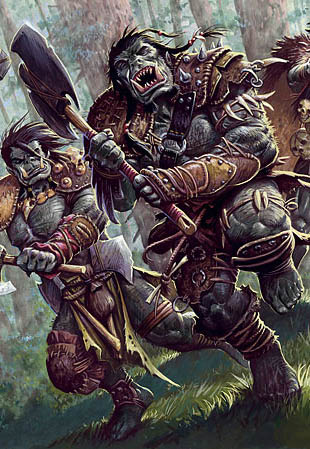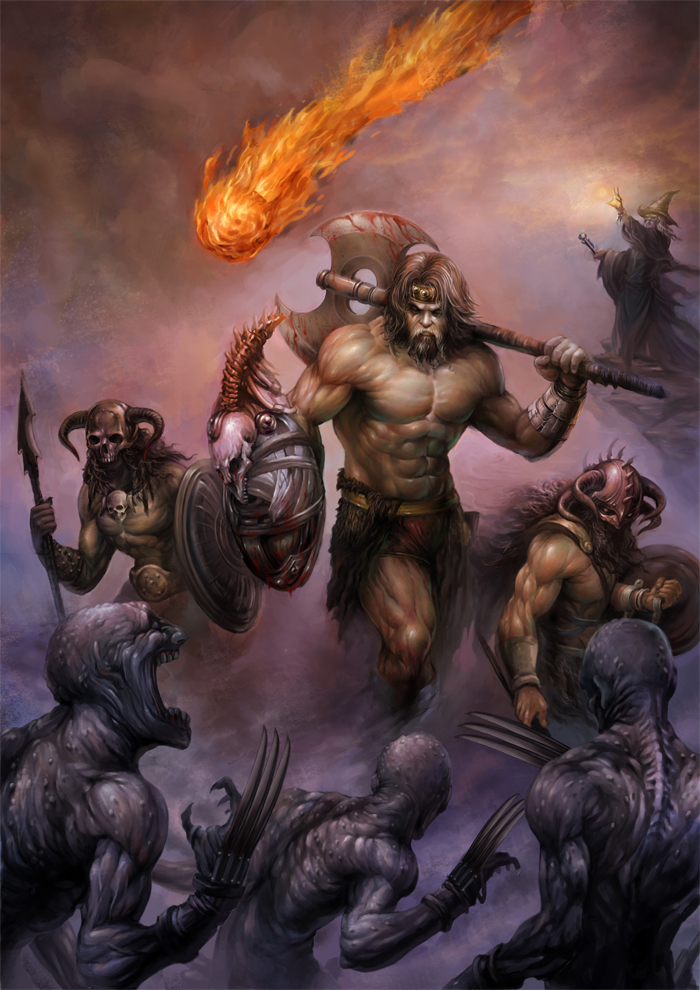Verda’s Tribes
I’ve made more than a few references to the tribes of humanoids living in Verda. There’s so many of them, it can be difficult to keep track. These tribes are made of humans, orcs, goblins, hobgoblins, bugbears, gnolls, and more. Many tribes are undiscovered deep in the unexplored areas for Verda. This allows me to work-in new races and elements as supplements for D&D 5 begin to come out. Exploration Age is not limited because parts of the world still remain a mystery.
Similarities Amongst the Tribes

There are two similarities that all of Verda’s tribes share. These elements are designed to help my players and I keep the numerous Verdan peoples straight in our heads.
- All of the tribes are named after a beast, be it animal or other-worldly. e.g. Frog Tribe, Chimera Tribe, Remorhaz Tribe.
- All tribes worship the same set of four gods, one for each element. These gods favor neither evil nor good, law nor chaos, so their word is interpreted in many ways.
This way we don’t have a collection of thousands of gods to keep straight and the tribes are conveniently named and easily identified by a symbolic beast.
The Major Variances
Verda’s tribes can fall into a few major categories:
- Permanent or Nomadic – A tribe may have taken up a permanent residence in a ruin, natural holding such as a cave, or built their own permanent domiciles out of water material they had available. Many of Verda’s tribes have a more mobile life style, perhaps in tents or tepees. These nomadic people chase game and good weather, relying on both to sustain themselves.
- Isolationist or Open or Hateful – Some of Verda’s tribes are happy with the arrival of Findalayans and Parians. These new visitors bring exotic gifts and make good trade partners. Others prefer to ignore these new arrivals, observing from a distance to see what they might do before rushing to interact. A third category of tribes is unhappy with the way Findalay and Parian have claimed pieces of their homeland and deal with the tribes as inferior beings. This third category has decided these newcomers are their enemies and need to be put down and sent home.
- Small or Medium or Large – Most of Verda’s tribes are on the smaller side. Their populations are usually less than 100. The constant warring coupled with the recent plague and famine have kept the number of tribesman quite small. The medium tribes are between 100 and 200 people. Larger tribes can have as many as 500 members.
- Warring or At-Peace – At any given time there is roughly a 50% chance that a tribe is at war with another tribe. The violence does not usually take place in full-scale battles, but is more like a gang war. Each tribe sticks to its territory and only commits violence when they cross paths with enemies. Some organize raids on their enemies, but rarely are these tribes looking at full-scale extermination of one another. These wars can begin as disputes over resources and game, to show superiority, or some other reason.
- Racial Makeup – Most tribes are composed of humans, half-orcs, orcs, goblinkin, or some combination of all. There are other humanoids that also make up the tribes such as gnolls, ogres, and minotaurs, but there are fewer of these folk on Verda.
Minor Variances

Those major details help me (or any other DM) quickly flesh out a tribe. The little details are then up to me. Things to consider that might help a tribe feel unique:
- What natural game and plant life are around that the tribe might hunt and eat?
- Does this tribe value strength at arms? Strength in arcane magic? Divine magic? Psionics? Unarmed combat?
- Are men and women equals in this tribe? If not, which sex is the dominant one?
- What do their living structures look like?
- How do they get around? Mounts? Vehicles? On foot?
These questions are a great place to start when introducing a new tribe into the game!
Brief Overview of The Tribes History
The tribes have been on Verda almost as long as the tieflings. Their origins are unclear as they simply emerged from the The Sprawling Jungle, already worshipping their gods and divided into racially segregated tribe.
At first the tribes were racist and each believed its own to be the superior one. Many small and violent wars were had and smaller tribes ran to the outskirts of Verda, pushed away from the jungles by tribes with superior numbers. Even today, the tribes speak of The Beholder tribe which dominates the center of The Sprawling Jungle still pure in its strange racial makeup. They dare not head into the heart of the jungle, for there they may come face to face with the huge tribe that pushed all others further out into the world.
Over time, most other tribes softened in their views and accepted other races into their communities, even allowing marriage and mixed-race offspring to come into being. The tribes came together just as the morchia rose from the earth in an attempt to conquer Canus.
The tribes were great in number and for a long time they managed to hold out against the powerful morchia. Eventually though, their numbers dwindled and the morchia spread, even though warring tribes put aside differences to come together against a common foe. For over one thousand years this war raged, until the tieflings used The Reckoning Spell to end the war and drive the morchia back underground.
After that moment, the tribes always respected the might and power of the tieflings. When a tiefling comes into a tribe, they are treated with a healthy dose of respect… and fear.
The next problem for the tribes of Verda came in the form of the githyanki incursion. Githyanki, coming through a portal created by the tieflings, decided to take Verda as their own. They were less straight forward than the morchia, planting spies amongst the tribes and within the tiefling spires. Then the githyanki would strike suddenly and catch an entire settlement by surprise. The thriving tribes once again suffered many losses, until the tieflings opened a portal and made a pact with the githzerai. Together, the tribes, the tieflings, and the githzerai pushed back the githyanki. Today, the githyanki are still said to roam some of Verda’s mountains. The githzerai who did not return to their home plane retreated into the jungles and have not been heard from since after the war.
Since those two big wars, the tribes have continued their own skirmishes, survived The Tarrasque, harsh Winters, volcanic eruptions, and most recently a wide-spread plague. They are resilient people, smart, tough, and often they find pleasure in simple things like a good meal, a fierce battle, or a clever joke.

The Tribes Today
Today, the tribes have become alerted to the presence of other folk in the world and across the oceans. Some of the tribes have gotten along and traded with the peoples of Findalay and Parian. As time has gone on, however, even the most open tribes have learned that these newcomers can be dangerous.
Many of the settlers have their own fear of the people of the tribes, since the orcs of their homelands are always murderous and fierce, or they assume that if one tribe takes pleasure and fun in killing they all must. Racism and assumptions about the tribes living life as uncultured savages have led to many misunderstandings, some of which have ended in violence.
The tribes present yet another layer and shade of gray to added to Exploration Age. They make wonderful NPCs and help make the world rich and complex. The people of the tribes also present an opportunity to play a different kind of PC than someone from Findalay or Parian. A PC could be naive, inquisitive, introverted, or suspicious. An expert in one land, and a stranger in another.
Become a Patron!
If you like what you’re reading please consider supporting me on Patreon, supporting me on Ko-fi, follow me on Twitter, like World Builder Blog on Facebook, check out my podcasts, find my products on the DMs Guild, tell your friends about the blog, and/or leave me a comment and let me know you think. Thanks!